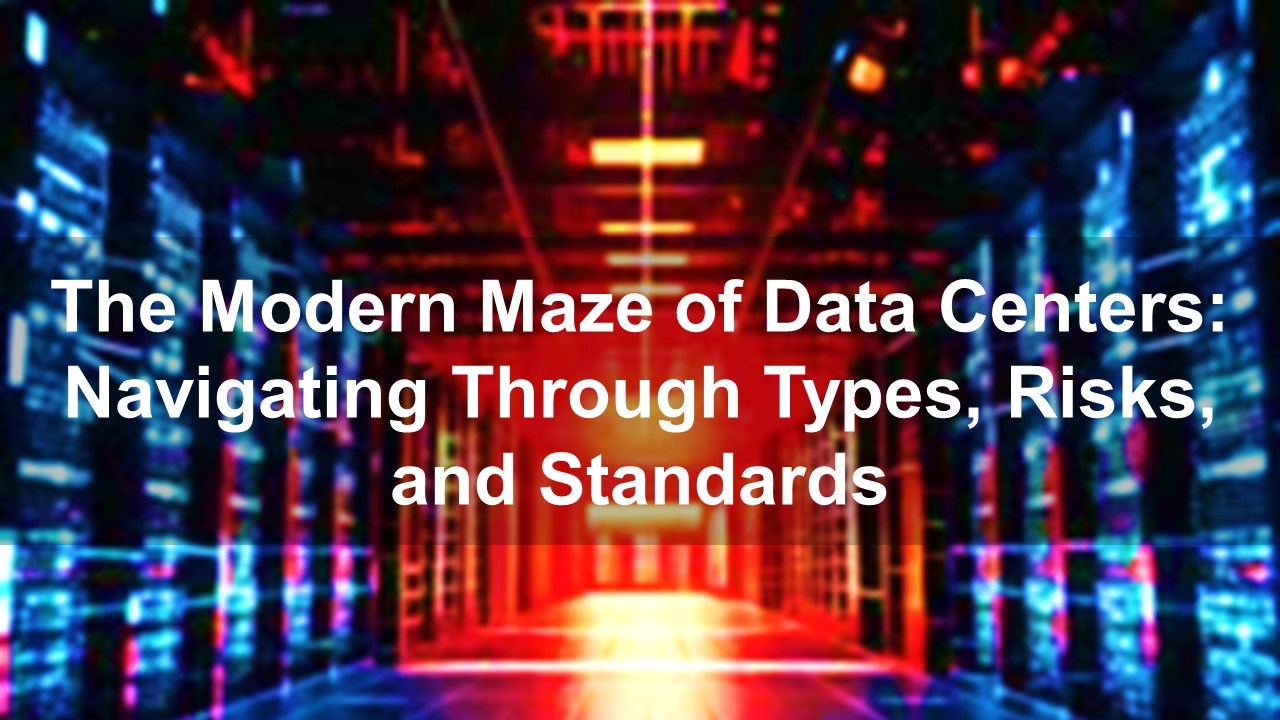The Modern Maze of Data Centers: Navigating Through Types, Risks, and StandardsIn the digital age, the backbone of our internet, cloud services, and essentially the entire online ecosystem rests on the shoulders of data Centres. These technological fortresses not only store, process, and distribute vast amounts of data but also ensure that this information is readily available and secure. Understanding the various facets of data Centres, from their types and associated risks to the standards governing them, is essential for businesses and tech enthusiasts alike. Let's delve into the intricate world of data Centres. The Five Pillars of Data Centres1. Enterprise Data Centres: Owned and operated by businesses, these data Centres are the traditional powerhouses of the corporate IT world. They house critical computer systems and components, including backup power supplies, ensuring the smooth operation of business processes. 2. Co-location (Colo) Data Centres: In the co-location model, a third party provides the physical space and necessary facilities, while the customer brings in their servers and storage solutions. This setup offers businesses flexibility and scalability without the high initial investment of building their own data Centre. 3. Cloud Data Centres: Cloud data Centres are operated by Cloud Service Providers (CSPs) and offer computing resources over the internet. They support various service models like Software as a Service (SaaS), Platform as a Service (PaaS), and Infrastructure as a Service (IaaS), underpinned by stringent Service Level Agreements (SLAs). 4. Hyperscale Data Centres: These are the behemoths of the data Centre world, owned by tech giants such as Google and Amazon. Hyperscale data Centres support massive scale operations, with at least 500 cabinets and occupying spaces of 10,000 square feet or more. 5. Edge Data Centres: Located close to the edge of networks, these data Centres are designed to deliver content with minimal latency. They are smaller but crucial for applications requiring quick data processing and delivery. Navigating Through Downtime and Risks Data Centre downtime is the bane of the digital world, leading to significant financial losses and operational disruptions. Downtime can result from power failures, human error, and various other factors. The average cost of downtime can be calculated based on the revenue lost during these periods, emphasizing the critical nature of data Centre reliability. Risks to data Centres are twofold: natural disasters like floods, and human-induced errors or vandalism. Among these, human error and equipment failures are the most significant contributors to data Centre outages. Types of Rating, 4 types namely:
Downtime means loss of ability for the DC due to power loss, surge and human error. Calculation of value loss for downtime: Average costs of downtime = Revenue loss due to downtime in $ / 8760 hr per year, where 8760 = 24 x 365 Standards and Selection: The Blueprint of ReliabilityThe reliability and efficiency of data Centres are governed by a mix of accredited and non-accredited standards such as ANSI/TIA 942, EN 50600, and the guidelines from the Uptime Institute. These standards outline specifications for everything from electrical setups and earthing to fire protection and environmental controls. When selecting a site for a data Centre, factors such as power availability, reliability, scalability, and operational costs are paramount. Future-proofing the selection means considering potential natural and man-made hazards, local infrastructure, and compliance with both local and international standards. The Future Is NowAs we continue to demand more from our digital services, the role of data Centres will only grow in importance. Understanding the different types of data Centres, the risks they face, and the standards that guide their operation is crucial for anyone involved in the tech industry, from executives and IT professionals to entrepreneurs.
In navigating the complex landscape of data Centres, it's clear that while the challenges are significant, the opportunities for innovation and efficiency are boundless. As we march forward into an increasingly digital future, the evolution of data Centres will undoubtedly be at the forefront of technological advancement.
0 Comments
Your comment will be posted after it is approved.
Leave a Reply. |
I am sharing these information with a caveat that these information is for educational purpose only and shall not be taken as an advice be it legal or otherwise. You should seek proper advice to your case with the relevant professionals. The author cannot guarantee the accuracy of the information so provided here.
Archives
March 2024
Categories
All
|
- Home
- About
-
Practice
-
DYA + C
-
Consultant
-
Educator
- Author I am...
- Speaking Engagement >
- Attempting Law School
- Journey in USM(Arch) >
- Discourse in Studio 6 >
-
d:KON 4
>
- Actors >
-
Acts
>
- Portraiture
- A Slice of Space Time
- Box of Installation of Lights
- Radio Misreading
- Grid of Destinies
- Shelter
- Anatomy of Pain
- Tensigrity of Ego
- Of Prisons and Walls
- Forest of Nails
- Curtain of Fears
- Dissolution of the Ego
- If it's Ain't Broken it's Ain't Worth Mending
- Flight of Freedom
- Cross of Complexity and Contradiction
- interrogation
- Stage >
- Play
- Approach
- Galleria >
- External Critique >
- Philosophy
- Codes Regulations & Standards >
- Photo Essays
- Contact




 RSS Feed
RSS Feed
